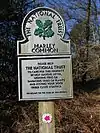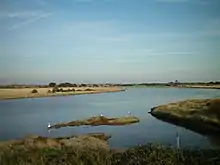List of hills of West Sussex
This is a list of hills in West Sussex. Many of these hills are important historical, archaeological and nature conservation sites, as well as popular hiking and tourist destinations in the county of West Sussex in southeast England.
Colour key
| Class | Prominence |
|---|---|
| Marilyns | 150 – 599 m |
| HuMPs | 100 – 149 m |
| TuMPs | 30 – 99 m |
| Unclassified | 0 – 29 m |
The table is colour-coded based on the classification or "listing" of the hill. The types that occur in West Sussex are Marilyns, HuMPs and TuMPs, listings based on topographical prominence. "Prominence" correlates strongly with the subjective significance of a summit. Peaks with low prominences are either subsidiary tops of a higher summit or relatively insignificant independent summits. Peaks with high prominences tend to be the highest points around and likely to have extraordinary views. A Marilyn is a hill with a prominence of at least 150 metres or about 500 feet.[1] A "HuMP" (the acronym comes from "Hundred Metre Prominence) is a hill with a prominence of at least 100 but less than 150 metres.[2]
In this table Marilyns are in beige and HuMPs in lilac. A "TuMP" as defined here is a hill with a prominence of at least 30 but less than 100 metres. The term "sub-Marilyn" or "sub-HuMP" is used, e.g. in the online Database of British and Irish Hills to indicate hills that fall just below the threshold. To qualify for inclusion, hills must either be 200 metres or higher with a prominence of at least 30 metres, below 200 metres with a prominence of at least 90 metres (the threshold for a sub-HuMP) or be in some other way notable. For further information see the Lists of mountains and hills in the British Isles and the individual articles on Marilyns, HuMPs and TuMPs. A "TuMP" as defined here is a hill with a prominence of at least 30 but less than 100 metres. By way of contrast, see also the article listing Tumps (a traditional term meaning a hillock, mound, barrow or tumulus).
Table
| Hill | Height (m) | Prom. (m) | Grid ref. | Class | Parent | Range/Region | Remarks | Image |
|---|---|---|---|---|---|---|---|---|
| Black Down[3] | 280 | 191 | SU919296 | West Sussex county top (historical and current), Marilyn, HuMP, TuMP | Beacon Batch[4] | Greensand Ridge | West Sussex's county top. Knoll at summit in trees, 30 m NNE of trig point. |
 |
| Littleton Down[3] | 254.9 | 149.2 | SU941149 | HuMP, TuMP, subMarilyn | Butser Hill | South Downs | West Sussex's second highest point Summit in trees |
 |
| Linch Down[3] | 248 | 111 | SU848173 | HuMP, TuMP | Butser Hill | South Downs | West Sussex's third highest point No summit feature. Summit is 15 metres ENE of the trig point. |
 |
| Glatting Beacon[3] | 245 | 98 | SU965131 | SubHuMP, TuMP | Butser Hill | South Downs | Trig point at summit. | |
| Beacon Hill[3] | 242 | 95 | SU965131 | SubHuMP, TuMP | Butser Hill | South Downs | Tumulus at summit. | |
| Chanctonbury Ring (Chanctonbury Hill)[3] | 240 | 217 | TQ138120 | Marilyn, HuMP, TuMP | Leith Hill[4] | South Downs | Summit on western edge of ring. |  |
| Harting Downs[3] | 229 | 68 | SU794183 | TuMP | Butser Hill | South Downs | Grassy summit. |  |
| Devil's Dyke[3] | 217 | 114 | SU794183 | HuMP, TuMP | Ditchling Beacon | South Downs | Summit within 2 metres of trig point. |  |
| Marley Heights[3] | 216 | 53 | SU890302 | TuMP | Black Down, Sussex | South Downs | Beech tree on summit, east of the farm. |  |
| Truleigh Hill[3] | 216 | 67 | TQ225108 (est.) | TuMP | Ditchling Beacon | South Downs |  | |
| West Harting Down[3] | 216 | 80 | SU762187 | TuMP | Butser Hill | South Downs |  | |
| Kithurst Down[3] | 213 | 111 | SU762187 | HuMP, TuMP | Butser Hill | South Downs | Featureless summit; 5 metres south of trig point. |  |
| Farm Hill[3] | 212 | 63 | SU961145 | TuMP | Butser Hill | South Downs | Crop field at summit. | |
| Hatch Farm Hill[3] | 211 | 43 | SU898298 (est.) | TuMP | Black Down | South Downs | ||
| West Hill[3] | 211 | 89 | TQ279117 | TuMP | Ditchling Beacon | South Downs | No summit feature. |  |
| Barlavington Down[3] | 208 | 55 | SU961155 | TuMP | Butser Hill | South Downs | No summit feature. Arable field. |  |
| Telegraph Hill, Sussex[3] | 207 | 130 | SU870264 | HuMP, TuMP | Black Down | South Downs | Summit is 5 metres NW of a bungalow. |  |
| Bow Hill[3] | 206 | 74 | SU824112 (est.) | TuMP | Butser Hill | South Downs |  | |
| St Roche's Hill[3] | 206 | 57 | SU877110 (est.) | TuMP | Butser Hill | South Downs |  | |
| Wolstonbury Hill[3] | 206 | 66 | TQ283138 (est.) | TuMP | Ditchling Beacon | South Downs |  | |
| Bedham Hill[3] | 155 | 122 | TQ014221 | HuMP, TuMP | Black Down | South Downs | Flat, featureless summit, partly covered in trees. |  |
| Thorney Island[3] | 6 | 6 | SU765019 (est.) | "Significant Island of Britain"[3] | None | Possible alternative summit by church. |  |
See also
- List of mountains and hills of the United Kingdom
- List of Marilyns in England
References and footnotes
- Dawson, Alan (1992). The Relative Hills of Britain. Milnthorpe: Cicerone Press. ISBN 1-85284-068-4. Archived from the original on 2010-09-21.
- Jackson, Mark. "More Relative Hills of Britain" (PDF). Relative Hills of Britain. Archived from the original (PDF) on 12 October 2013. Retrieved 31 March 2013.
- Name, height, prominence, parent, grid and class data from: Database of British and Irish Hills, retrieved 28 Dec 2016.
- Mark Jackson, More Relative Hills of Britain, Lulu: 2009. pp. 144-145
- Name, height, prominence, grid, class and parent data from: Jackson, Mark (2009). More Relative Hills of Britain, Marilyn News Centre, UK, p. 168. E-book Archived 2013-10-12 at the Wayback Machine.
